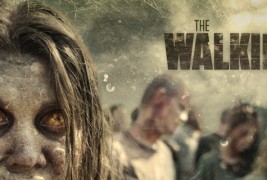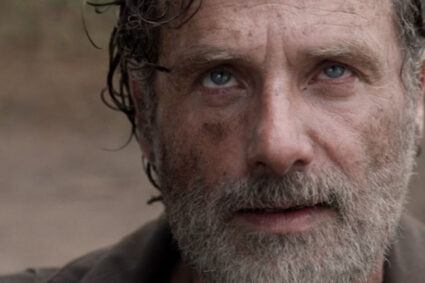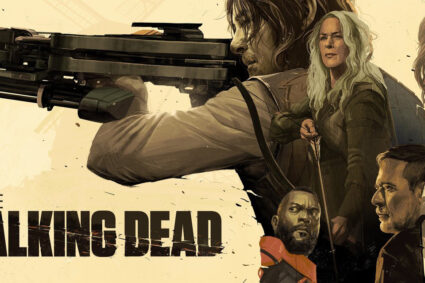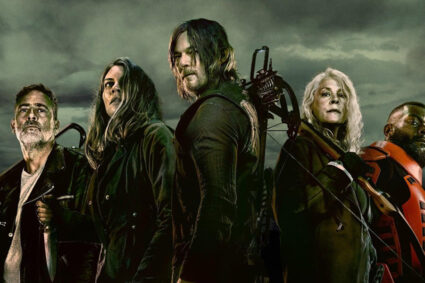
A couple years ago the news that a name-filmmaker, Frank Darabont, was adapting Robert Kirkman’s long-running zombie apocalypse comic book series into a television show was noteworthy to say the least. Though I’ve never had to resist the urge to run through the streets screaming, “Darabont’s a genius,” I was excited about the A-list backing of top notch source material. And as it turns out, the first season of The Walking Dead was good. I gave it a solid B and while it never fired on all cylinders – most television shows don’t right away and there were only six episodes – it exhibited more than enough potential to elicit my genuine excitement for Season Two.
Then news of a massive purge involving the show’s writers’ room followed by news of a mysterious and elusive change in Darabont’s capacity as a creative force in the show’s production awoke the insufferable pessimist living inside my head. At that point it appeared as if the writing was on the wall. However, to my surprise and absolute joy, the reasons behind those decisions to shake things up are now irrelevant. And whoever made them really is a genius because Season Two of The Walking Dead has vaulted to the top of the heap as one of the best things on television, period.
Season Two begins shortly after our ragtag group of survivors escape from the CDC in Atlanta. The group heads toward Fort Benning, but the roadway becomes impassable, cluttered with abandoned and wrecked vehicles. Set upon by a horde of zombies, the group takes cover in and under vehicles, but terrified young Sophia (Madison Lintz) dashes into the woods when a Walker gets too close for comfort. Rick (Andrew Lincoln) and the others set off beneath the forest canopy to find her. When Rick catches up to her, they’re besieged by more zombies, forcing Rick and Sophia to split up.
Sophia never returns to the road and during a subsequent search and rescue excursion, Rick’s son Carl (Chandler Riggs) is accidentally shot and grievously wounded by a survivor who resides at a nearby farm. The entire group sets up their base camp at the farm, owned by Dr. Hershel Greene (Scott Wilson), an elderly veterinarian, and his family. In a mad dash to acquire the necessary medical equipment to save Carl’s life, Shane’s (John Bernthal) true colors come to fore. When Dr. Greene and various members of the group become suspicious of each other, accusations fly and secrets are revealed that rain dirty laundry and formerly-closeted skeletons down upon everyone. But perhaps the biggest secret of all is the one hidden away amongst the hay and the horses at the farm-sanctuary our group calls home.
Thus far, each episode of Season Two ends in a cliff hanger the potency of which I haven’t experienced in a great while, since maybe the heyday of prime Buffy and Angel. I’ve audibly gasped, mouth agape, at nearly every final shot of each episode. To say the show is addictive is like saying David Copperfield is fun at parties. And provided you’re lucky enough to be caught unaware, the midseason finale culminates in a scene that will blow your mind like a shotgun blast to the dome.
The success of The Walking Dead resides in its well-written, multidimensional characters, played to perfection by a wonderful cast, including the youngsters. The characters are all archetypes – the good cop (Rick), the bad cop (Shane), the father figure (Dale), the loose cannon (Andrea), and so on, but each of them have a well-conceived facet of their personality that’s at odds with the expectations one has of their respective type. The greater the discrepancy between these opposing character-dimensions, the more interesting the character is. An example of this is the breakout performance of Norman Reedus whose portrayal of redneck, tough guy Daryl Dixon is outstanding. Daryl’s compassionate, empathetic traits fly in the face of his tough exterior. They’re also perfect opposites of the behavior we witnessed from his vile brother, Merle Dixon (Michael Rooker), last season. It’s compelling and it begs the question: How far does the apple fall from the tree? It seems like sometimes the apple may even be an orange.
Some of you are surely reading this and thinking, “Blah, blah, good acting, blah, blah, writing, whatever.” Fear not, there’s plenty of red meat for those of you who couldn’t care less about namby-pamby drama. The Walking Dead takes full advantage of the deliciously disgusting amounts of gore allowed on TV these days. Shows such as Bones, CSI, and Criminal Minds have pushed the envelope of eviscerated corpses well beyond anything I could have imagined 25 years ago. But the corpses in The Walking Dead aren’t lying prone on an autopsy table, made less grisly by a sterilized laboratory aesthetic. No, they’re stumbling about, occasionally catching and devouring live victims. And to represent this horror, KNB EFX Group provides the bloody brilliance. Moreover, the FX are mostly comprised of practical, physical gags – no pun intended. It’s true they’re supplemented with CGI, but that’s unavoidable given the show’s tight shooting schedule and budgetary constraints. The Walking Dead will not disappoint those of us who get a good kick in the pants when the nasty stuff starts flying.
The Walking Dead successfully transcribes to our screens the elements of the comic book series that set it apart from other zombie-centric panel-and-page nightmares. The show isn’t just a quick fix for gore-junkies who lack attention spans and that’s because it takes the long view of what happens to people over time after a zombie plague. At its core the show is a character drama wherein the zombie apocalypse is just a device to force characters from various walks of life into a high stakes situation in which they’re forced to rely on each other. They no longer have the comfort of tribalism based on race, sex, age, money, or religion. The only thing they all have in common is the will to survive which must take precedence over the myriad differences among them. It makes for fantastic drama, rife with tension and complex obstacles, and the zombie element is truly frightening because of the context and tone established by these character-driven elements.
Hopefully the show’s incredible execution and momentum half way through Season Two continues after the winter break when the show resumes in February, 2012. Regardless of genre, The Walking Dead is television at its finest and it’s exactly the quality of storytelling horror fans need to get behind. Fortunately, it would seem that’s exactly what we’re doing as the Season Two premiere shattered the previous basic cable ratings record and prompted the AMC brass to sign on the dotted line for Season Three.
For me, this midterm grade is an easy A.
2 thoughts on “The Walking Dead Season 2 Midterm Report Card”
Comments are closed.















My feelings are mixed. The zombies have been reduced to barely dangerous cannon fodder…worst scene had to be the pair stuck in six inches of water in a creek and then roped like misbehaving dogs. They are almost incidental to the human drama, which wasn’t the case in the first season. However, that human drama is pretty strong in itself. Creepiest thing in Season 2 is Shane’s descent into madness. Or is it madness? Maybe his approach makes the most sense in world without laws…but it also makes the humans ultimately much more dangerous than a slow, stupid and easy to “re-kill” dead person.
Hey Doc,
I actually heard this criticism a lot the first season. Thing is, in all of the best regarded examples of the zombie subgenre, the zombies are incidental to the human drama. From the inception of Romero’s zombies in ’68, they were just a device/metaphor, albeit a cool one that allows for gore and violence. But the last scene in the movie when the redenck shoots Ben in the head, the die was cast as to what the real danger is in a world beset with the plague. However, the zombie plague can just as easily be bird flu, nuclear winter, etc. In order to sustain a series, either in comic book form or on television, the engine of the drama can’t emphasize the zombies. That gets dull by the end of an 80 minute direct to video cheepy. Also, The Walking Dead takes place after the plague has run roughshod over our civilization, which changes the complexion of what scenes involving zombie hordes look like. Aside from their strength in numbers, isolated, rotting corpses are barely dangerous cannon fodder at this point.
But…different strokes. Again, I’ve had this debate with multiple people last year, so maybe I’m in the minority. Thanks for the comment, Doc.